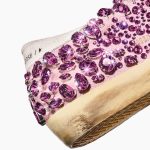After 26 years, Sarah Burton will leave British luxury fashion house Alexander McQueen. When the former McQueen intern took the helm of the brand in 2010 following the death of the eponymous designer, she faced an almost insurmountable challenge. Succeeding a designer as beloved and glorified as Lee Alexander McQueen is no easy feat – and yet there was a consensus within the atelier that Burton was the only one fit for the job, according to the magazine ‘The Cut’. The years to come would confirm just that, as few designers would have taken on the responsibility with more finesse, skill, and pride than Burton has.
Her departure marks the end of another era for the fashion house, as her successor will most likely know the brand’s legacy and the designer McQueen only from tales, books and documentaries.
Where did Burton begin and McQueen end?
Burton shared McQueen’s love of Britain’s nature and history, but while McQueen himself often cast his fashions in the shadows, Burton added a lighter, softer touch to the razor-sharp tailoring the brand was known for. That said, particularly in the beginning, it was at times difficult to tell where McQueen ended and Burton began, and yet over time Burton transformed the late designer’s gothic warriors into a softer, more romantic version of themselves. While it’s impossible to talk about Burton without inevitably referencing McQueen, it’d be a disservice to Burton not to acknowledge that under her romantic signature, the brand has continued to blossom and, – one might say – emerge from the darkness.
It’s a path Burton – whether subconsciously or intentionally – set with her first solo collection for the brand. The spring/summer 2011 show was opened by a model dressed all in white, her eyes obscured by contact lenses and her face framed by braids. She was dressed in a tailcoat. “The tail coat is a trad McQueen piece, but here it was softened, its edges unfinished, and the hard, peaked shoulders that were another McQueen signature had been slashed open, relaxed,” wrote fashion critic Tim Blanks for Vogue Runway.
While her early collections in particular were marked by a level of attention to detail, tailoring and scale almost comparable to couture – the ten looks inspired by the Anglican Church that Burton presented for Fall/Winter 2013 are said to have taken two weeks per outfit, according to Blanks – the designer turned to increasingly commercial collections as the years went by
The birth of a new British luxury brand
With an increasing focus on wearable fashion, the once central theme of storytelling also increasingly receded into the background. While McQueen was a dreamer, it had always been Burton’s job to translate his visions and ground them in reality. When McQueen made Burton head of design during his lifetime, part of her job was to translate each season’s runway looks into commercial styles, The Cut wrote in a profile of Burton earlier this year. While the label once appealed particularly to industry insiders, fashion enthusiasts and art students besotted with McQueen’s creative genius, Burton transformed the label into a global luxury brand that combined commerce with exceptional craftsmanship – all without losing its identity. Little wonder, then, that Burton’s leadership of McQueen, while not necessarily providing the brand with the same media buzz as her mentor, kept the business moving along steadily.
Although parent company Kering, which took over the McQueen brand in 2001, does not explicitly break down the label’s annual sales, a report by Vogue – citing Morgan Stanley analyst Édouard Aubin – said they rose from 220 million euros in 2014 to 830 million euros in 2021, and then to 830 million euros in 2022.
In the first half of 2023, the tide seems to have turned for French luxury goods group Kering SA, which is currently undergoing a broad restructuring. Sales for the company as a whole increased only marginally, and Kering’s so-called “Other Houses” division, which includes Balenciaga and Alexander McQueen among others, reported a 5 percent year-on-year decline in first-half sales to 1.9 billion euros. Kering’s financial report in July nevertheless emphasised that McQueen’s Ready-to-Wear “performed well”.
Whether the performance ultimately was not good enough, whether Burton’s departure is related to the numerous internal changes within the company, or whether it was perhaps the designer herself who is saying goodbye to her “family” after 26 years, as she referred to the McQueen team in a statement published by Kering, will probably remain a matter of speculation. However, it would be desirable that her legacy, much like that of her former mentor, boss and friend, will not be forgotten, but will find its way into the history books of Alexander McQueen.



